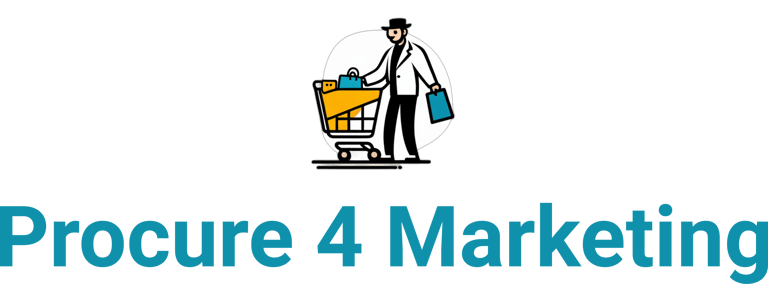Implementing Value-Based Procurement Strategies
What is value-based procurement? This guide explains what it is, the 4 key benefits, and a 5-step process for implementing a value-driven strategy.
SUPPLY CHAIN
The Procure 4 Marketing Team
12/21/20234 min read


Quick Answer: What is value-based procurement?
Value-Based Procurement (VBP) is a strategic approach that focuses on obtaining the best long-term value from a purchase, rather than just the lowest initial price. It involves a holistic evaluation of suppliers and services based on criteria like quality, innovation, reliability, and sustainability, in addition to cost. The goal is to align procurement decisions with the company's overall business objectives to drive sustainable growth and a stronger competitive advantage.
What is Value-Based Procurement?
Value-Based Procurement (VBP) represents a fundamental shift in mindset from a cost-centric to a value-centric approach.
Traditional Procurement: Asks, "How can we get this for the lowest possible price?"
Value-Based Procurement: Asks, "Which supplier and solution will deliver the best possible outcome for our business in the long run?"
This means considering the Total Cost of Ownership (TCO) and the strategic impact of a purchase, not just its price tag.
A Simple Analogy: Think of buying a car. A purely cost-based decision would be to buy the cheapest car available. A value-based decision would be to buy a slightly more expensive car that has better fuel efficiency, higher safety ratings, and lower long-term maintenance costs, providing better overall value over its lifetime.
Why is VBP a Competitive Advantage? (The 4 Key Benefits)
Adopting a VBP model delivers strategic benefits that go far beyond simple cost savings.
1. It Reduces the Total Cost of Ownership (TCO)
A cheaper product can often be more expensive in the long run. VBP focuses on minimizing the total cost over a product's entire lifecycle.
Real-World Example: A company chooses to buy higher-quality, slightly more expensive office printers. These printers use less ink and require 50% less maintenance than the cheaper alternative, resulting in a lower TCO and significant savings over three years.
2. It Improves Quality and Performance
Prioritizing quality in your procurement decisions directly enhances your own product or service, boosting customer satisfaction and brand reputation.
Real-World Example: A gourmet food company sources premium, ethically-sourced ingredients. While more expensive, this commitment to quality allows them to market their product as a premium offering, command a higher price, and build a loyal customer base.
3. It Drives Innovation Through Strategic Partnerships
VBP encourages building long-term, collaborative relationships with suppliers. These strategic partners are more likely to share new ideas, technologies, and process improvements.
Real-World Example: An electronics company works closely with its key microchip supplier. The supplier, treated as a partner, gives the company early access to its next-generation chip, allowing them to launch a faster, more innovative product ahead of their competitors.
4. It Enhances Brand Reputation
By incorporating sustainability and ethical standards into your evaluation criteria, VBP aligns your supply chain with your corporate values and meets the growing consumer demand for responsible business practices.
Real-World Example: A fashion brand commits to sourcing only from suppliers that are certified for fair labor practices. They use this commitment in their marketing, which enhances their brand reputation and attracts ethically-conscious consumers.
How to Implement a Value-Based Procurement Strategy: A 5-Step Guide
Transitioning to a VBP model is a strategic process that requires careful planning and communication.
Step 1: Identify Your Company's Key Value Drivers
The first step is to understand what "value" means for your specific business. Sit down with leadership and key stakeholders to align on the company's strategic goals. Is the primary driver innovation, sustainability, speed-to-market, or customer satisfaction?
Step 2: Redefine Your Evaluation Criteria
Update your supplier selection criteria to reflect these value drivers. Move beyond a simple price comparison to a more holistic supplier scorecard that includes weighted scores for:
Total Cost of Ownership (TCO)
Quality and Performance Metrics
Innovation Capabilities
Sustainability and Ethical Standards
Reliability and Risk Profile
Step 3: Foster Strategic Supplier Relationships
Identify your most critical suppliers and begin the shift from a transactional relationship to a strategic partnership. This involves open communication, joint planning, and setting shared goals for mutual success.
Step 4: Educate Stakeholders and Get Buy-In
Overcoming internal resistance to change is a major challenge. The key is clear communication.
Actionable Tip: Run training workshops for your team and other departments to explain the long-term benefits of VBP. Use pilot programs to demonstrate the success of the new approach with tangible results, such as a case study showing how a higher-quality supplier led to a 30% reduction in customer complaints.
Step 5: Measure and Communicate Your Success
Track and report on the new value-based metrics. Showcasing successes is the best way to reinforce the new mindset.
Actionable Tip: Create a quarterly "Value Report" for leadership that highlights not just cost savings, but also metrics like supplier-led innovations, improvements in product quality, and progress toward sustainability goals.
Frequently Asked Questions (FAQ)
Q1: Is Value-Based Procurement always more expensive upfront?
Not necessarily, but sometimes it can be. The core principle is that a higher initial investment is justified if it leads to a lower Total Cost of Ownership or provides a significant strategic benefit (like superior quality or innovation) that outweighs the initial cost.
Q2: How do you convince leadership to shift from a pure cost-saving mindset?
The best way is to speak their language: data and financial impact. Build a business case that quantifies the long-term benefits. Show them, for example, how a 5% increase in material cost could lead to a 20% decrease in customer returns and warranty claims, resulting in a net positive financial impact.
Q3: Can a small business implement VBP?
Absolutely. A small business can start by applying VBP principles to its most critical purchases. For example, a small software company might choose a more expensive but highly reliable cloud hosting provider because the cost of an outage (in lost revenue and reputation) would be far greater than the initial savings from a cheaper, less reliable option.

